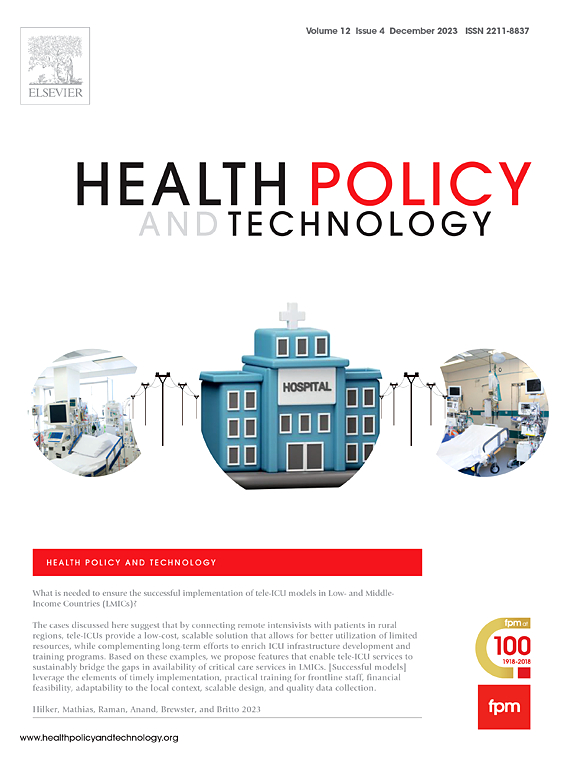坦桑尼亚公共初级卫生保健设施中EHR系统可用性和提供者满意度的决定因素
IF 3.7
3区 医学
Q1 HEALTH POLICY & SERVICES
引用次数: 0
摘要
坦桑尼亚通过GoTHoMIS等系统优先采用电子病历系统,以加强医疗保健服务和数据管理。然而,EHR实施的成功主要取决于系统可用性和医疗保健提供者的满意度,这影响系统的接受度和持续使用。目的:本研究评估坦桑尼亚公共初级卫生保健机构医疗服务提供者的电子病历系统可用性和满意度的决定因素。具体目标是检查EHR系统可用性对提供者满意度的影响,组织因素的作用,可用性对系统使用频率的贡献,以及人口统计学和专业群体之间的差异。方法对多马和达累斯萨拉姆地区288名医疗服务提供者进行横断面定量调查。根据EHR系统实施成熟度,有目的地选择代表城市、城郊和农村的区域。数据通过谷歌表格进行结构化问卷调查收集。谷歌表单数据经过加密,并符合坦桑尼亚2022年数据保护法。采用多元线性回归和SmartPLS结构方程模型分析影响电子病历系统满意度和使用频率的因素。结果工作效率的提高是服务提供者满意度的最强预测因子(β = 0.258, p <;0.001),其次是系统可靠性、充分的培训和组织支持。整合到临床工作流程的便利性和加强协作等因素显著预测了电子病历系统的使用频率。人口统计变量的调节作用有限。一般来说,系统可用性、组织环境和可感知的效率收益对于成功采用EHR至关重要。结论:在坦桑尼亚初级卫生保健机构实施有效的电子病历系统需要一个复杂的方法,不仅要解决技术可用性问题,还要解决组织支持、用户培训和工作流程集成问题。政策干预应优先考虑这些领域,以提高用户满意度和系统可持续性。本研究着眼于坦桑尼亚的医疗保健提供者如何使用电子健康记录系统,这是存储患者信息的数字工具。结果表明,当记录可靠、易于使用,并得到强有力的培训和领导支持时,卫生保健工作者更满意并更频繁地使用系统。这些见解可以帮助医疗机构改进数字系统,为患者提供更好的医疗服务本文章由计算机程序翻译,如有差异,请以英文原文为准。
Determinants of EHR systems’ usability and provider satisfaction in public primary healthcare facilities in Tanzania
Background
Tanzania has prioritized EHR systems adoption through systems like GoTHoMIS to enhance healthcare delivery and data management. However, the success of EHR implementation depends critically on system usability and healthcare providers’ satisfaction, which influence system acceptance and continued use.
Objectives
This study assessed the determinants of EHR system usability and satisfaction among healthcare providers in Tanzania’s public primary healthcare facilities. Specific objectives were to examine the influence of EHR system usability on provider satisfaction, the role of organizational factors, the contribution of usability to frequency of system use, and variations across demographic and professional groups.
Methods
A cross-sectional quantitative survey was conducted among 288 healthcare providers in Dodoma and Dar es Salaam regions. The regions were purposively selected to represent urban, peri‑urban and rural settings based on EHR system implementation maturity. Data were collected through a structured questionnaire administered via Google Forms. Google Forms data were encrypted and complied with Tanzania’s Data Protection Act 2022. Multiple linear regression and Structural Equation Modeling using SmartPLS were employed to analyze factors associated with EHR systems satisfaction and usage frequency.
Results
Improvement in work efficiency was the strongest predictor of provider satisfaction (β = 0.258, p < 0.001), followed by system reliability, adequate training, and organizational support. Factors such as ease of integration into clinical workflows and enhancement of collaboration significantly predicted the frequency of EHR system use. Demographic variables had limited moderating effects. Generally, system usability, organizational environment, and perceived efficiency gains were critical for successful EHR adoption.
Conclusion
Effective EHR systems implementation in primary healthcare settings in Tanzania requires a complex approach addressing not only technical usability but also organizational support, user training, and workflow integration. Policy interventions should prioritize these areas to enhance user satisfaction and system sustainability.
Public interest summary
This study looked at how healthcare providers in Tanzania use electronic health record systems, which are digital tools for storing patient information. The results showed that healthcare workers were more satisfied and used the systems more often when the records were reliable, easy to use, and supported by strong training and leadership. These insights could help healthcare organizations improve digital systems and make healthcare services better for patients
求助全文
通过发布文献求助,成功后即可免费获取论文全文。
去求助
来源期刊

Health Policy and Technology
Medicine-Health Policy
CiteScore
9.20
自引率
3.30%
发文量
78
审稿时长
88 days
期刊介绍:
Health Policy and Technology (HPT), is the official journal of the Fellowship of Postgraduate Medicine (FPM), a cross-disciplinary journal, which focuses on past, present and future health policy and the role of technology in clinical and non-clinical national and international health environments.
HPT provides a further excellent way for the FPM to continue to make important national and international contributions to development of policy and practice within medicine and related disciplines. The aim of HPT is to publish relevant, timely and accessible articles and commentaries to support policy-makers, health professionals, health technology providers, patient groups and academia interested in health policy and technology.
Topics covered by HPT will include:
- Health technology, including drug discovery, diagnostics, medicines, devices, therapeutic delivery and eHealth systems
- Cross-national comparisons on health policy using evidence-based approaches
- National studies on health policy to determine the outcomes of technology-driven initiatives
- Cross-border eHealth including health tourism
- The digital divide in mobility, access and affordability of healthcare
- Health technology assessment (HTA) methods and tools for evaluating the effectiveness of clinical and non-clinical health technologies
- Health and eHealth indicators and benchmarks (measure/metrics) for understanding the adoption and diffusion of health technologies
- Health and eHealth models and frameworks to support policy-makers and other stakeholders in decision-making
- Stakeholder engagement with health technologies (clinical and patient/citizen buy-in)
- Regulation and health economics
 求助内容:
求助内容: 应助结果提醒方式:
应助结果提醒方式:


